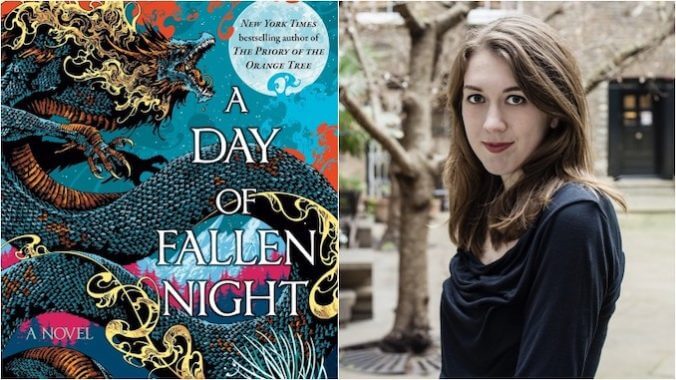Samantha Shannon On the Unexpectedly Timely Themes of A Day of Fallen Night and How History Often Alters Women’s Stories
Photo: Louise Haywood-Schiefer
Samantha Shannon’s Roots of Chaos series is the epitome of everything that’s right about the fantasy genre right now: A rich, sprawling, female-focused tale that spans centuries and kingdoms, these are doorstopper old-school fantasy epics that are tremendously easy to get lost in. Beautifully written and meticulously plotted, both The Priory of the Orange Tree and its prequel, A Day of Fallen Night ground sweeping, potentially apocalyptic events in emotional, deeply human stories of connection, love, and family.
A story of dragons and queens, warrior mages, and religious scholars literally spread across the four corners of the world, both books essentially focus on the age-old conflict between humankind and the monstrous servants of a great wyrm known as the Nameless One who sleeps at the center of the earth. The various legends surrounding his creation, eventual defeat, and subjugation all vary depending on the culture of the historians telling the story, but one thing is clear: The threat is ever present, and vigilance is required. (Though what those protective measures should be will also depend on who you ask.)
The history of the Nameless One and the various figures connected to his initial rise and defeat is but one example of Shannon’s rich, detailed worldbuilding throughout this series, which fuses half a dozen seemingly disparate kingdoms and central characters into a cohesive whole, grounding them in centuries of the sort of history and myth that feel as though they belong in a college-level antiquities class.
“I’m going to completely horrify you by saying that I just have a really good memory,’ author Samantha Shannon laughs when asked how she keeps the specifics of her sprawling universe straight. “But in terms of worldbuilding—and I do this with my Bone Season series as well—the way I build worlds is essentially by asking myself questions and forcing myself to come up with the answers. It might be like, don’t know, says that you have a very cold country—how do people keep warm? Or vice versa for a hot country, how do they keep cool? If it’s a desert country, how are they getting water? I just keep asking myself questions and the more I come up with answers, hopefully, each one of those answers is like a little stitch in a tapestry, giving the world depth and texture. “
A Day of Fallen Night is technically a prequel to The Priory of the Orange Tree. Set centuries before the events of that novel during a tragic period known as the Grief of Ages, when deadly wyrms rise from the earth, leaving destruction and a deadly plague in their wake, its characters have long since passed into the realm of legend by the time Priory takes place. But for its author, setting A Day of Fallen Night in a time period so far removed from the events of the series’ first novel was strangely freeing.
“I think the temptation when you write a prequel, and I think Star Wars was guilty of this a little bit, is that you want the characters to be ready to be moved into their positions for the sequel as quickly as possible and so that’s how we end up with Ben Kenobi kind of sitting around in the Tatooine desert for presumably quite a long time,” she says. “But I didn’t really feel as much of a need to rush all of the characters into position for The Priory of the Orange Tree. I might have felt like that if the book was set, I don’t know, say a year or five years before, I would’ve felt more pressure to make the world by the end of this story, look like it does in Priory. But because it’s such a long time, I just had to get the world to a place where I felt comfortable.”
To be fair, Fallen Night does contain plenty of moments that will resonate with those that have read Priory and which will one day help create and inform the world of that novel.
“I do try to make connections with Priory—for example, you see the establishment of the Red Damsels in this book, you see the end of the Seiikinese monarchy when it’s replaced with the warlords,” Shannon explains. “But I didn’t feel the pressure to make it exactly the same, because 500 years is an immensely long time. And it felt like there was still so much more room for the world to develop and also just to recover from the Grief of Ages because it was such a cataclysmic event that it would take quite a long time for the world to get back to how it looks in Priory.”
Unexpectedly, perhaps, Shannon’s complex fantasy series takes the bulk of its inspiration from a famous real-world myth.
“In terms of actually coming up with the concept of this world, it stemmed from the fact that I love dragons,” Shannon says. “That started when I was really young because I watched this movie called Dragonheart that barely anyone has ever heard of. And then also I was raised in the Church of England, where the story of St. George and the Dragon came up quite a lot. He’s the patron saint of England and also this sort of military Christian saint, and I was really interested in that legend and where it came from.”
Her research led her through many versions of St. George’s story, which is a basic sort of damsel in distress tale, in which a handsome knight rescues a beautiful princess from a monster. But, Shannon says she was particularly interested in one version of the story which contained, as she puts it, “conditional heroism,” In which St. George promises to save the land being tormented by the dragon but only if its residents convert to Christianity.
-

-

-

-

-

-

-

-

-

-

-

-

-

-

-

-

-

-

-

-

-

-

-

-

-

-

-

-

-

-

-

-

-

-

-

-

-

-

-

-








































